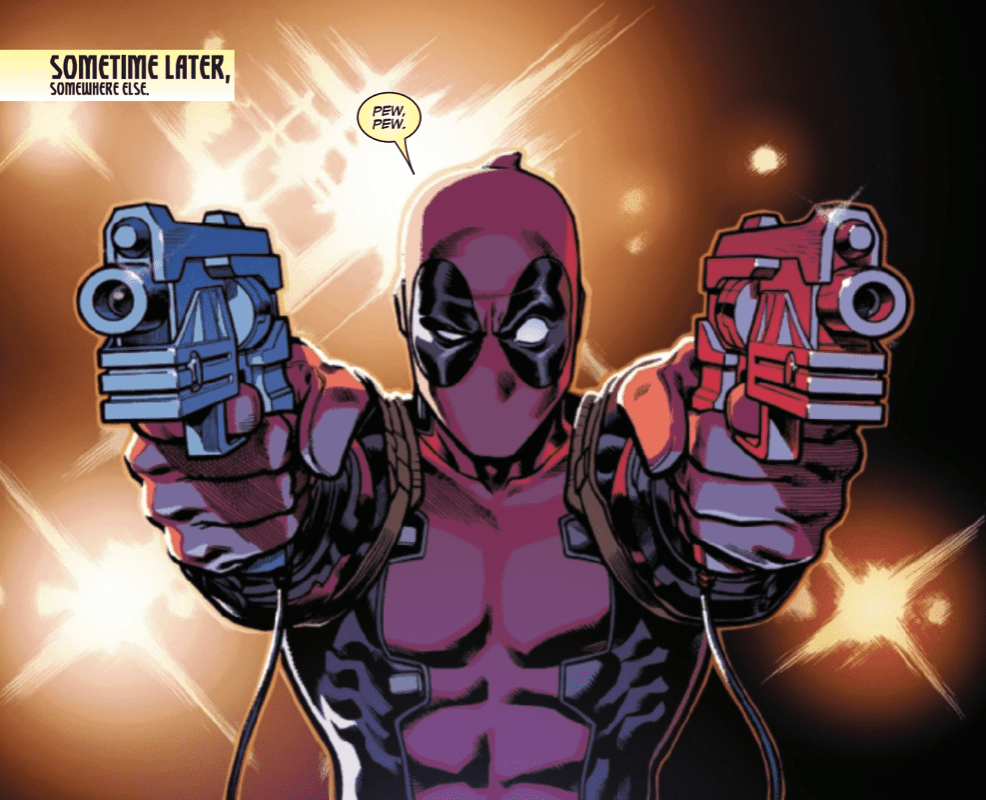In Marvel Comics’ Deadpool Annual #1 (on sale August 21), writer Dana Schwartz forces Wade Wilson to face the worst nightmares of others, which makes the Merc With A Mouth confront some gritty, uncomfortable truths. But the issue misses the mark because it doesn’t allow Wade to face his own fears.

Deadpool Annual #1
Writer: Dana Schwartz
Penciler: Reilly Brown
Inkers: Nelson DeCastro with Craig Yeung
Color Artist: Matt Herms with Guru-eFX
Letterer: VC’s Joe Sabino
Sometimes, the thing fans love the most about Deadpool can be the character’s most glaring weakness. The Regenerating Degenerate is known for cracking wise and approaching life with a sarcastic sense of humor. This levity can be bittersweet, though. That’s abundantly clear in Deadpool Annual #1.
Schwartz doesn’t explicitly describe the relationship between eight-year-old Peter Quincy and his adult neighbor Mr. Hewitt. With that being said, it’s heavily implied that Hewitt abuses Peter, which leads the boy to request Deadpool’s services. The reveal of the abuse doesn’t arrive until the climax of the issue. The journey to that point is filled with Deadpool brushing off the words of Nightmare, the villain he’s forced to face as part of the “Acts of Evil” line. In typical Deadpool fashion, the antihero makes jokes almost every time Nightmare opens his mouth. This behavior undercuts Nightmare’s credibility as a villain and also makes it difficult to take the plot seriously.

Deadpool laughs at everything the villain throws at him, including a visit to a dream sequence in which President Abraham Lincoln mourns the loss of life in the Civil War. By the time the intended twist (Peter’s relationship with Hewitt) arrives, the reader is so detached from the story that even this emotional moment fails to resonate. Throughout the comic, there’s clearly a missed opportunity for some character growth. Wade could confront his own fears and potentially move past them. Instead, he focuses on Peter and Nightmare chooses to flex his muscle by taking Wade to two irrelevant dreamscapes. As a result, the comic doesn’t successfully dig deep enough to stand apart from its predecessors.
It’s par for the course for Deadpool to excessively insult his villains and soften the tone of the story; but other comics have struck a more effective balance between attempted humor and serious content.
On the surface, it’s hard to evaluate a Deadpool comic because they’re supposed to be funny. Humor is inherently subjective so it’s unfair to write one of these comics off because the success of the comedy depends on the reader. But the best Deadpool stories genuinely capture the character’s voice and, more often than not, Schwartz fails to do so here.
Whether it’s in the movies or the comics, Deadpool’s pop culture references are one of the many reasons he’s such a fan-favorite. Usually, these references are timely or, at the very least, they’re accessible. Here, Schwartz packs a number of dated nods to pop culture characters into the story. In the span of a few pages, Wade calls a mailman Cliff Clavin, Mr. McFeeley, Herman Post and Willie Lumpkin. Readers who immediately understood these references might find that they worked well. Others who had to google the names to understand the attempted joke will probably disagree.
Time and again, the jokes don’t land. In a Deadpool comic, that’s a problem. At one point, Wade claims, “I guess I’m not exactly ‘haha’ funny. More like ‘New Yorker Cartoon‘ funny. So…no, [I’m] not very funny.” Actually, at his best, Deadpool is one of the funniest characters in comic books. The two movies starring Ryan Reynolds as the Merc With a Mouth are perfect examples of that.

To be fair, the comedy does work a few times in this issue. Early on, Peter invites Deadpool into his room. In this scene, the comedic timing is impeccable. “I did write some other letters…maybe just two or three…hundred to Squirrel Girl,” the boy says. The line is split between two panels. In this sequence, the collaboration between penciler Reilly Brown and letterer VC’s Joe Sabino is one of the best elements of the comic.
First, Brown focuses on Peter so the reader can’t see the rest of his room. The next panel allows the kid to complete the line and the viewer to see Peter’s obsession with Squirrel Girl. Between the reveal that he sent hundreds of letters to the hero and the fact that his room is absolutely filled with merchandise displaying the character’s likeness, this moment showcased the creative team’s sense of humor.

The comedy is elevated by the illustration of the memorabilia. Brown, inkers Nelson DeCastro with Craig Yeung and color artists Matt Herms with Guru-eFX make Peter’s room feel like it belongs in the Joker’s circus. In the corner, a stuffed animal of Squirrel Girl looks terrifying; the black shadowing around its eyes make the toy look more like Pennywise the Clown than a friendly superhero. Just a few feet away, Peter’s headboard prominently displays Squirrel Girl’s face. This design is creepy in a different way. The face looks friendly but it’ll still be horrifying to wake up and see it staring at you in the middle of the night. Thanks to the art team, these designs turn Peter’s room into a off-putting shrine of Squirrel Girl. It’s fair to assume that Deadpool would view the room in that lens and the artists exquisitely convey that mindset.
Fans of the Merc With a Mouth will want to like Deadpool Annual #1. Though some of the comedy is effective, it usually fails to connect and it dilutes the gravity of the plot. Ultimately, it’s up to the reader to decide whether the comic is still worthwhile if that’s the case.
What do you think of Deadpool Annual #1? What do you hope to see Wade do next?

